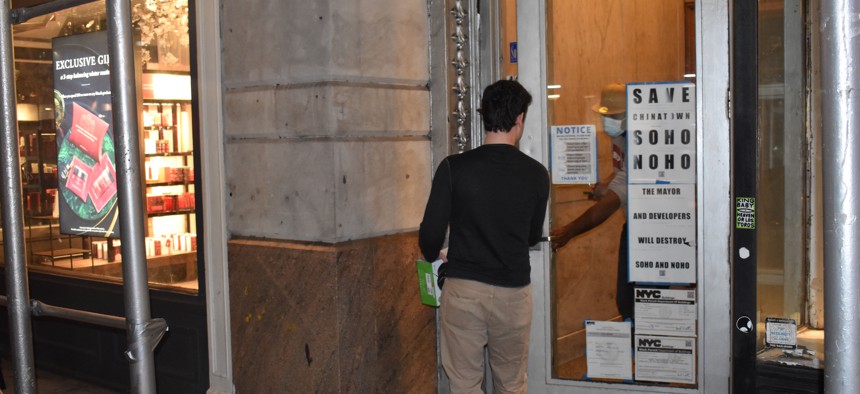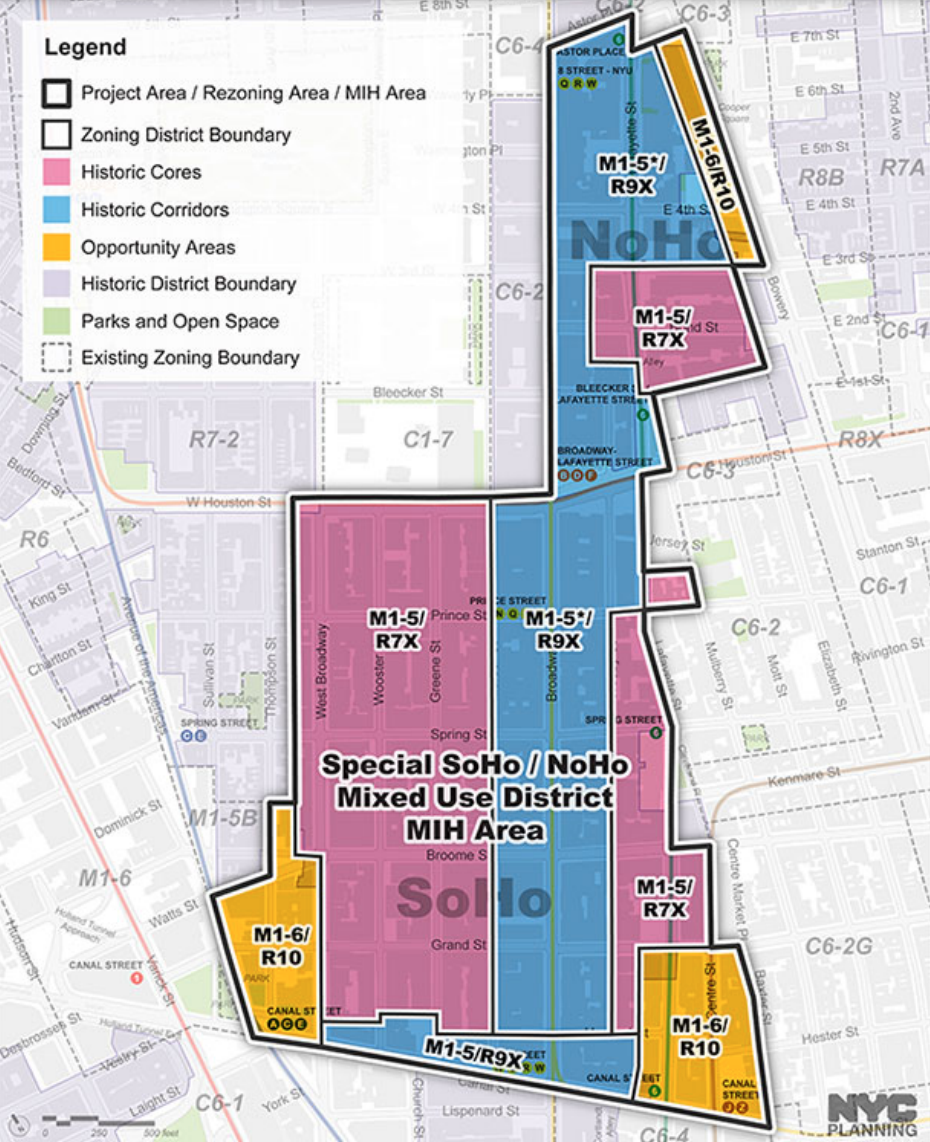Housing
Will the SoHo/NoHo rezoning help or harm Chinatown? Depends who you ask.
Opponents and proponents can’t agree on anything really – including where Chinatown’s borders are.

City planners insist Chinatown isn’t part of the rezoning plan, but opponents have made it a flashpoint in the debate. Gabriel Poblete
Around the SoHo and NoHo neighborhoods in Manhattan, urgent and minimalist posters are taped onto some building windows. The black and white posters read in all caps “SAVE CHINATOWN SOHO NOHO.” Between the big bold letters, they say that a community coalition of individuals and organizations are standing up against the city’s plan to upzone SoHo, NoHo, Little Italy and Chinatown. They go on: “Protest the gentrification of Chinatown.”
The posters are a rallying cry against the city’s proposed SoHo/NoHo Neighborhood Plan rezoning. But for a plan billed by the city as a rezoning of the well-off neighborhoods known for cobblestone streets and flagship stores of famous fashion brands, the poster brings up one question: What’s Chinatown got to do with this?
With New York City Mayor Bill de Blasio in the final months of his tenure, few policy goals remain on his plate. Two of those are the Gowanus and the SoHo and NoHo rezonings to increase the density of residents living in those wealthier areas. Rezonings are changes to building rules approved by the City Council that determine what kinds of structures are allowed to be built in a given area. While the Gowanus rezoning seems to be headed toward approval, the Soho and NoHo rezoning has a murkier future. Community Board 2 adopted a resolution against the rezoning by a 37 to 1 vote, and Manhattan Borough President Gale Brewer, whose recommendation is part of the city’s Uniform Land Use Review Procedure, said the rezoning still needs work, but sidestepped giving a definitive thumbs-up or thumbs-down. However, the City Planning Commission approved the rezoning unanimously last month, so it’ll now head to the City Council, the final step in the city’s zoning process.
Recent rezonings have spurred development in lower-income parts of the city more vulnerable to gentrification. The SoHo and NoHo rezoning differs from many of the previous rezonings, even more so than the Gowanus rezoning, because it would occur in wealthy, mostly white enclaves of the city. As is often the case with proposed land use changes, there are plenty of arguments against the SoHo and NoHo rezoning: Critics say it’ll ruin the integrity of the neighborhoods without substantially increasing the stock of affordable housing, it’s a giveaway to developers, and it’ll lead to the demolition of historic buildings.
But Chinatown, a neighborhood with ambiguous boundaries that is home to more immigrants and people with middle and lower incomes, has become a flashpoint of the debate. Those who are saying that Chinatown will be negatively impacted argue that the rezoning will lead to more displacement of residents while also claiming that the proposed rezoning area does, indeed, include a portion of the historic neighborhood, pointing to areas along Canal Street and east of Lafayette Street. But the city’s planning department as well as elected officials and some housing advocates have held steadfast that Chinatown is not part of the rezoning area. Some housing advocates go so far as to say that opponents are trying to muddy the waters by throwing a lower-income neighborhood into the conversation.

The proposed 56-block rezoning goes as far north as Astor Place and is bounded by Canal Street on the south, while stretching as far west as Sixth Avenue on the east, although most of the proposed rezoning area is west of Lafayette Street. The area hasn’t been rezoned in five decades, and the new plan will allow for new housing to be built, which is currently only achievable under special permits. According to the city, the rezoning is estimated to spur the development of as many as 3,000 new housing units, of which approximately 900 would be permanently affordable according to the city’s mandatory inclusionary housing.
City planners told City & State that Chinatown is not part of the rezoning. The city’s position is that the rezoning would relieve the pressure on Chinatown and other abutting neighborhoods because there will finally be more new housing in SoHo and NoHo.
"Today, when housing is built in SoHo and NoHo, it is luxury housing, and that means that many people who want to live in these two communities but can’t afford it are forced to go elsewhere where housing is allowed, including neighborhoods like Chinatown, which in turn drives up the cost of that housing.” said Erik Botsford, deputy director of the Manhattan division at the Department of City Planning.
Despite the city’s position, several activists against the rezoning have argued that it does include Chinatown, especially along Canal Street and in some of the pockets that go beyond Lafayette Street. Village Preservation, an advocacy group set on preserving the architectural integrity of several neighborhoods including NoHo, has been spearheading efforts against the rezoning. The organization, which held a presentation with a neighborhood nonprofit Think!Chinatown, has claimed that more than 1,200 affordable housing units in the adjacent Chinatown area stand would be indirectly threatened by the rezoning.
Andrew Berman, the executive director of Village Preservation, rebuffed the idea that Village Preservation is including Chinatown in the rezoning debate in bad faith. He said that the wealthy people in the rezoning area are not those who would be impacted. Rather, it’ll be those in rent regulated apartments and the ones who live in the areas Village Preservation says are Chinatown.
“We're not the ones who put Chinatown in this rezoning proposal, that's 100% on the city,” Berman said. “and it's true that the rezonings that the city has done before, which were bad, were in predominantly low income neighborhoods. That doesn't mean that there aren't also similar bad effects from a rezoning like this in a neighborhood like this.” For Zishun Ning, one of the organizers of Youth Against Displacement, the rezoning is one of several land use changes threatening Chinatown’s residents. Along with the SoHo/NoHo rezoning, Youth Against Displacement and activists with similar goals have been also dealing with the Two Bridges Rezoning that would lead to luxury apartment buildings and a finger-pointing standoff involving the mayor’s plan for a borough-based jail in Manhattan.
Ning, who doesn’t live in Chinatown, said the rezoning will only lead to luxury housing, which he believes will affect not only the areas of Chinatown he says are within the proposed rezoning area, but Chinatown at large. Several groups have been pushing the city for a different kind of rezoning dubbed the Chinatown Working Group Plan. The Chinatown and Lower East Side plan includes height limitations for new buildings, limits on the number of hotels in the areas, and affordable housing.
“We see that the problem is how the city encourages these kinds of luxury developments across the city that will drive up the rents and the real estate tax,” Ning said. “So we feel we need to speak out against this type of displacement agenda and really unify the community to fight for the protection of the majority of us, including workers, tenants and small businesses.”
The rezoning area falls into Council Members Margaret Chin’s and Carlina Rivera’s districts, and both members could play an important role in the rezoning passing the final hurdles. Chin, who is term-limited and whose district includes all of Chinatown, and Rivera, who is vying to lead the City Council next year, came out saying the rezoning needs to feature more affordable inclusionary housing, and the planning department must listen to advocacy groups. Chin did not elaborate further on whether she supports the rezoning, but her office did say that the council member does not believe Chinatown is part of the rezoning.
However, someone who does believe the rezoning does include some of Chinatown is Christopher Marte, the Democratic nominee for Council District 1, Chin’s district. Marte has come out in opposition to the rezoning as it stands, and has told City & State he believes the rezoning vote should not be held until after the incoming class of council members assume their seats in January. He said there has not been sufficient outreach to the Chinatown community.
“At the end of the day, the city just wants to do what they want to do and ignore communities of color,” he said. “It would have been easy for them to continue to do outreach, do as much outreach as they did in SoHo, NoHo in that area.”
Casey Berkovitz, a board member at pro-housing advocacy group Open New York, told City & State that the SoHo and NoHo rezoning is necessary, with neighborhoods like those not contributing enough to the city’s tight housing stock. While he has said the rezoning could use some work, especially when it comes to prioritizing residential use over office space, he said that rezoning neighborhoods that are predominantly white, as opposed to Black and brown communities, should be the priority.
Berkovitz said that neighborhood borders are fluid. He is critical of the Village Preservation’s analysis, saying that they “played fast and loose with neighborhood borders.” Ultimately, he said that while preserving the character of SoHo and NoHo is important, the neighborhoods’ tight zoning that does not allow for more housing is something that shouldn’t be preserved.
“Anything we can be doing to create affordable housing, to create new housing in extremely well-served, wealthy, high-amenity areas, and to racially and socioeconomically integrate what are extremely white wealthy neighborhoods … is a step in the right direction,” Berkovitz said.
NEXT STORY: Will New York pull the plug on Bitcoin mining?

